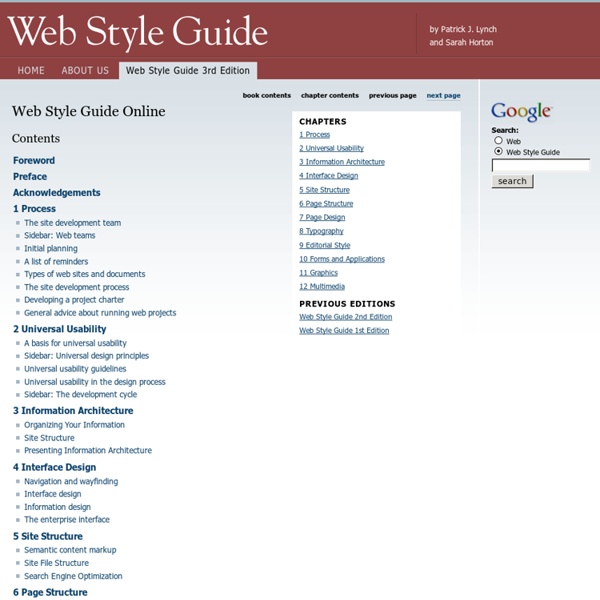



http://webstyleguide.com/wsg3/index.html
Related: UXData collection for usability research Taking notes in usability tests Anyone who has ever conducted a usability evaluation of a web site, software application, or consumer product, knows that human behaviour research often produces reams of data that can take significant time to analyse. To be productive, researchers must organize and reduce these data so that they can quickly perform their analysis and proceed with improving the product. People who are new to the field tend to take notes on paper or on a computer.
Si le recours aux wireframe est adoptée par beaucoup d'agences web, le recours à un prototype ergonomique fonctionnel de tout le site améliore la qualité des sites créés Si le recours aux wireframe est adoptée par beaucoup d'agences web, le recours à un prototype ergonomique fonctionnel de tout le site améliore la qualité des sites créés. Nous présentons dans cet article les atouts de la conception de sites Internet basée sur le recours à un prototype ergonomique fonctionnel. Ergonomie et création de sites Internet
How To Use Color To Enhance Your Designs People are physically, psychologically, and socially influenced by color. Color has been found to have connections to health and it can help set the mood through which your designs are seen. Color communicates meaning and so we need to be conscious of what meaning we’re conveying when we choose to use one color over another. It’s not enough for a designer to use a color simply because he or she likes that color. Affordances The concept of an affordance was coined by the perceptual psychologist James J. Gibson in his seminal book The Ecological Approach to Visual Perception. The concept was introduced to the HCI community by Donald Norman in his book The Psychology of Everyday Things from 1988. There has however been ambiguity in Norman's use of the concept, and the concept thus requires a more elaborate explanation.
10 Faune Entièrement gratuit et Applications Maquette: Magazine Design Speckyboy Every web designer and developer should have a good and reliable wireframe (mockup or prototype) tool at there disposal. The importance of such a tool differentiates amongst web designers and developers, some use them, some don’t. Personally, I use them. It is in this initial stage of development that makes web design enjoyable, the coming together of the clients needs and your own creative ideas onto a blank canvas, allowing you to plan effectively the visual arrangement of the sites content. How to Choose a Typeface Advertisement Choosing a typeface can be tricky. The beauty and complexity of type, combined with an inexhaustible supply of options to evaluate, can make your head spin.
Downloads The following SVG, EPS, and PNG files should be used for print publications. Please see our policies page for more information about how our logos may be used. CC logos and trademarks should always be downloaded from this page to ensure high quality. Downloads from other sites may not conform to our standards and may result in improper display or use of our protected logos and trademarks. The SVG and EPS vector files are recommended for use in print materials — The standard screen resolution files will appear blurry or jagged if used in print. There are links to large format, high quality PNG versions of each graphic for web, print, presentations, and video.
5 Signs of a Great User Experience If you’ve used the mobile social network Path recently, it’s likely that you enjoyed the experience. Path has a sophisticated design, yet it’s easy to use. It sports an attractive red color scheme and the navigation is smooth as silk. It’s a social app and finding friends is easy thanks to Path’s suggestions and its connection to Facebook. In short, Path has a great user experience. That isn’t the deciding factor on whether a tech product takes off. Copyright Fair Use and How it Works for Online Images You’ve heard the adage that a picture is worth a thousand words, but when that picture is protected by copyright, the picture is only worth three words: cease and desist. OK, that’s kind of a lawyer joke. But it illustrates how protective people are about finding their images used online without permission. Copyright laws were established not to give the author the right to deny their work to other people, but instead to encourage its creation. Article I, Section 8, clause 8, of the United States Constitution states the purpose of copyright laws is “to promote the Progress of Science and useful Arts, by securing for limited times to Authors and Inventors the exclusive Right to their respective Writings and Discoveries.”
Widgets “You are Here” indicator a way of indicating the current location (or view area) when looking at an overview map, site map, navigation bar, etc. The indicator can be as simple as a dot, a bounding rectangle, an arrow, or a hilited item. Choosing the Right Colors for Your Web Site Do colors influence web site visitors? When creating a site, choosing the optimum colors is one of the most difficult tasks that arise in spite of the apparent easiness. Choosing the perfect chromatic palette is important in order to effectively communicate the message, in order to strengthen the idea of a unique entity and to create brand awareness. How to choose colors?